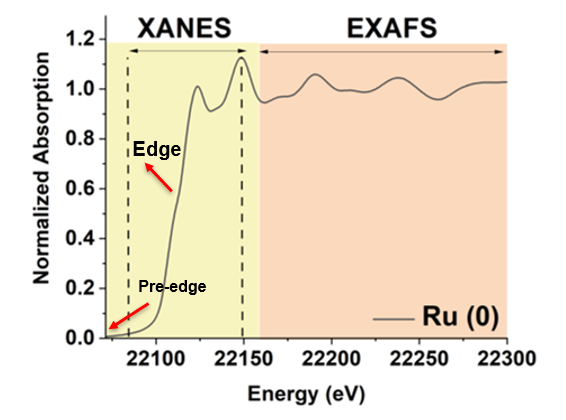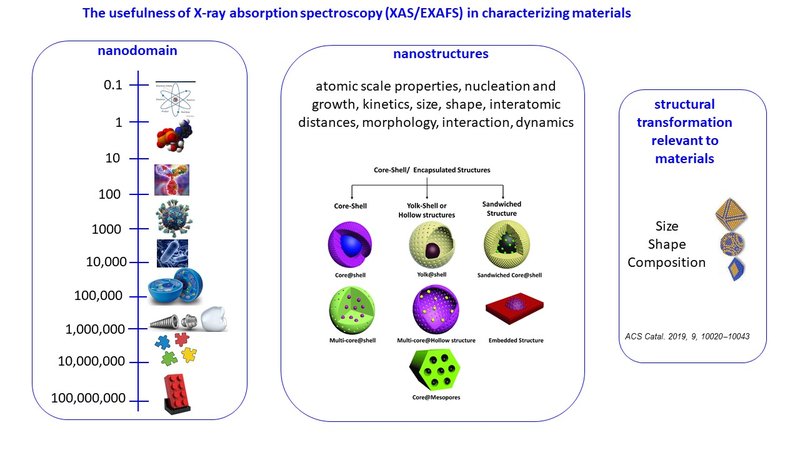What is XAS?
X-ray absorption spectroscopy (XAS) is the measurement of the modulation of the X-ray absorption coefficient at energies near and above an X-ray absorption edge. The measurement is divided into two regimes, XANES (X-ray Absorption Near-Edge Structure) and EXAFS (Extended X-ray Absorption Fine-Structure).

A few noticeably features of such spectra are:
- Before the edge, there is a region called pre-edge
- The edge is a rapid increase, followed by a region known as XANES (X-ray absorption near-edge structure). The XANES spectra depends on the specifics of the material and it is used to identify the oxidation states, among others.
- EXAFS (Extended X-ray absorption fine structure) is the region that extends beyond the XANES region. The Fourier transform of the EXAFS region contains information about the scattering atoms' local environment in the sample.
How Can XAS be Useful?
X-ray absorption spectroscopy (XAS) is a versatile and powerful probe of local structural, chemical speciation and electronic structure and can be applied to a wide range of experimental systems. The BioXAS - Spectroscopy beamlines are designed to measure dilute biological, agriculture, geological materials and catalyst samples. The typical measurement modes are X-ray absorption near edge spectroscopy (XANES) and extended X-ray absorption fine structure (EXAFS). For detailed theory and discussions please see the brief introduction and resources link.
In general, XAS can give you local structural information, chemical speciation, electronic structure and simultaneous speciation and location. At BioXAS samples can be measured as liquids or solids and there are many methods of sample preparation. A XAS measurement at the near edge spectrum can be used for fingerprint matching of a sample and chemical speciation. An EXAFS measurement of oscillations gives accurate bond lengths and information about number and type of coordinated atoms. XANES provides information on the electronic state, whereas, EXAFS can provide - geometric environment relevant to the absorbing atom.



- XAS should be used to compliment laboratory techniques – should not be the first characterization of your sample!
- Raman, FTIR, DRIFTS, IR, UV-vis, NMR
- SEM, TEM, AFM
- XRD, SAXS/WAXS, PDF
- TGA, DSC
Example uses


- EXAFS
- Non-crystalline materials-solution or liquid species, amorphous solids, gas phase species
- Nanoparticles
- Minority species - aqueous ions adsorbed on a surface, trace elements in a mineral, dopant atoms in solid state materials
- Large crystal structures
- XANES
- Electronic Structure
- Probes unoccupied electronic levels
- Ligand Field Theory
- Orbital Occupancies
- Site symmetry
- Covalency



What questions can XAS answer?
- XANES - Electronic state
- Where are the electrons
- What is the oxidation state, valency or co-ordination chemistry
- EXAFS - geometric environment
- How many neighboring atoms are there
- what is there chemical speciation
- Information about particle size
- Information on oxidation state
- Information of type ( is it oxide, is it a carbide, is it metallic)
- what is the bond length? Insight into how reactive or inactive the material is
- Where are the atoms
- What element is the element of interest bonded to
- How many of each type of element
- What are the respective bond lengths
User cases
- Element speciation (XANES)
- Biological samples (enzymes, plants)
- geological samples (soil, mine tailings)
- Electronic structure (XANES)
- catalysts - different conditions
- phase transitions
- Crystal structure (EXAFS)
- doping - local distortions
- static and thermal disorder
- Note - for XRF imaging contact BioXAS imaging staffhere
- Element speciation (XANES)
Limitations of XAS
- Nyquist Criteria
- Round Robin Test for cross referencing data on same sample at different beamlines. Visit Comparison of EXAFS foil spectra from around the world
- F-Test or Hamilton Test for statistical relevance and physical sense. Online Beta Function Calculator
- S/N ratio v time of data collection
- low oscillations far out in k space
- k space dampening due to temperature
- Bulk Technique in the conventional sense ( not useful for surface or interface phenomenon)
- shape and geometry can be extracted up to 6 Angrstoms
Beamline papers
Below are examples of beamline papers in respective fields
- Materials
- Randell, Nicholas M.; Miclette Lamarche, Renaud; Tintori, Franceso; Chernikov, Roman; Welch, Gregory C. et al. (2021). Photodeposited Polyamorphous CuOx Hole-Transport Layers in Organic Photovoltaics. ACS Applied Energy Materials 4(11) , 12900-12908. 10.1021/acsaem.1c02577.
- Agriculture
- Haja, Dominik K.; Wu, Chang-Hao; Ponomarenko, Olena; Poole, Farris L.; George, Graham N. et al. (2020). Improving Arsenic Tolerance of Pyrococcus furiosus by Heterologous Expression of a Respiratory Arsenate Reductase. Applied and Environmental Microbiology 86(21) . 10.1128/aem.01728-20.
- Health/BioLife Sciences
- Singh, Jaskaran; Panahifar, Arash; Chernikov, Roman; Dust, William N. (2024). Pelvic Pseudotumor Associated With a Ceramic Bearing Total Hip. JAAOS: Global Research and Reviews 8(3):e23.00184. 10.5435/JAAOSGlobal-D-23-00184.